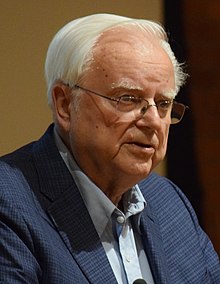
Back فرانك دريك Arabic فرانك درييك ARY فرانك دريك ARZ Frank Dreyk Azerbaijani فرانک دریک AZB Фрэнк Дональд Дрэйк Byelorussian Франк Дрейк Bulgarian ফ্রাঙ্ক ড্রেক Bengali/Bangla Frank Drake Catalan Frank Drake Czech
Frank Drake | |
|---|---|
 Drake speaking at Cornell University in 2017 | |
| Born | Frank Donald Drake May 28, 1930 Chicago, Illinois, U.S. |
| Died | September 2, 2022 (aged 92) Aptos, California, U.S. |
| Alma mater | |
| Known for | |
| Spouses | Elizabeth Procter Bell
(m. 1952; div. 1976)Amahl Shakhashiri (m. 1978) |
| Children | 5, including Nadia |
| Scientific career | |
| Fields | Astronomy, astrophysics |
| Institutions | University of California, Santa Cruz, SETI |
| Doctoral advisor | Cecilia Payne-Gaposchkin |
Frank Donald Drake (May 28, 1930 – September 2, 2022) was an American astrophysicist and astrobiologist.
He began his career as a radio astronomer, studying the planets of the Solar System and later pulsars. Drake expanded his interests to the search for extraterrestrial intelligence (SETI), beginning with Project Ozma in 1960, an attempt at extraterrestrial communications. He developed the Drake equation,[1] which attempts to quantify the number of intelligent lifeforms that could potentially be discovered. Working with Carl Sagan, Drake helped to design the Pioneer plaque, the first physical message flown beyond the Solar System, and was part of the team that developed the Voyager record. Drake designed and implemented the Arecibo message in 1974, an extraterrestrial radio transmission of astronomical and biological information about Earth. He is the father of Advanced SETI.
Drake worked at the National Radio Astronomy Observatory, Jet Propulsion Laboratory, Cornell University, University of California at Santa Cruz and the SETI Institute.
- ^ Physics Today 14 (4), 40–46 (1961). Drake, F. D. (April 1961). "Project Ozma". pubs.aip.org. American Institute of Physics. Retrieved April 27, 2023.
The question of the existence of intelligent life elsewhere in space has long fascinated people, but, until recently, has been properly left to the science‐fiction writers.